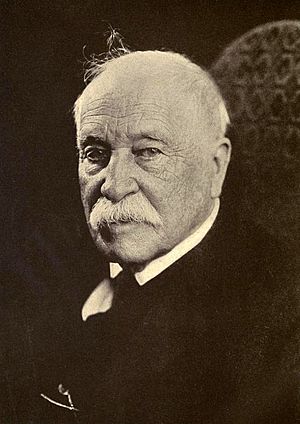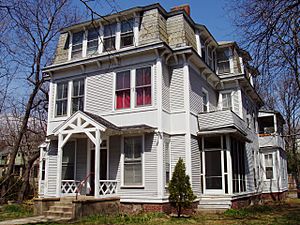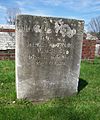William Dean Howells facts for kids
Quick facts for kids
William Dean Howells
|
|
|---|---|
 |
|
| United States Consul to Venice | |
| In office 1861–1865 |
|
| Appointed by | Abraham Lincoln |
| Preceded by | J. J. Sprenger |
| Personal details | |
| Born | March 1, 1837 Martins Ferry (then Martinsville), Ohio, U.S. |
| Died | May 11, 1920 (aged 83) Manhattan, New York, U.S. |
| Spouse | Elinor Mead |
| Children | Winifred Howells (b. 1863) John Mead Howells (b. 1868) Mildred Howells (b. 1872) |
| Signature | |
William Dean Howells (born March 1, 1837 – died May 11, 1920) was an American writer. He was known for his realistic novels, his work as a literary critic, and his plays. People often called him "The Dean of American Letters" because he was so important in American writing.
Howells was famous for being the editor of The Atlantic Monthly magazine. He also wrote many books himself. Some of his well-known works include the Christmas story "Christmas Every Day" and the novels The Rise of Silas Lapham and A Traveler from Altruria.
Contents
About William Dean Howells
His Early Life and Family
William Dean Howells was born on March 1, 1837, in Martinsville, Ohio. This town is now called Martins Ferry, Ohio. He was the second of eight children born to William Cooper Howells and Mary Dean Howells.
His father worked as a newspaper editor and printer. Because of his father's job, the family moved around Ohio quite a bit. In 1840, they settled in Hamilton, Ohio, for nine years. This was the longest they stayed in one place.
Even though the family had to be careful with money, William's parents encouraged his love for reading and writing. From a young age, he helped his father with printing work. In 1852, his father even got one of William's poems published in a newspaper without telling him!
Starting His Career
In 1856, Howells got a job as a clerk in the Ohio House of Representatives. This was his first step into public life. Two years later, in 1858, he started working at the Ohio State Journal. There, he wrote poems and short stories. He also translated writings from French, Spanish, and German. He loved learning languages, especially German, and was very interested in the German writer Heinrich Heine.
In 1860, Howells visited Boston. He met many famous writers like Nathaniel Hawthorne and Ralph Waldo Emerson. He became good friends with some of them, including Henry Adams and Henry James.
Also in 1860, Howells wrote a book about Abraham Lincoln for his election campaign. Because of this, Lincoln later appointed him as a U.S. Consul in Venice, Italy.
On Christmas Eve in 1862, Howells married Elinor Mead in Paris. Elinor was the sister of a famous sculptor and a well-known architect. One of their children, John Mead Howells, also became an architect.
Becoming a Famous Editor and Writer
Howells and his wife returned to America in 1865 and made their home in Cambridge, Massachusetts. He started writing for popular magazines like The Atlantic Monthly and Harper's Magazine.
In 1866, he became an assistant editor at The Atlantic Monthly. He worked hard and became the main editor in 1871, staying in that role until 1881. During this time, he met Mark Twain in 1869, and they became lifelong friends.
Howells published his first novel, Their Wedding Journey, in 1872. But he became truly famous with his realistic novel A Modern Instance (1882), which was about a marriage falling apart. His 1885 novel, The Rise of Silas Lapham, became his most famous book. It tells the story of an American businessman who makes and loses his fortune.
He also wrote about important social issues of his time in novels like Annie Kilburn (1888) and A Hazard of New Fortunes (1890). He was very upset by the trials after the Haymarket Riot (a labor protest that turned violent). This event inspired him to write about similar riots in his books. He also spoke out against the trials. Howells joined the American Anti-Imperialist League in 1898, showing he was against the U.S. taking over the Philippines.
Howells was a leader in the "American realism" style of writing. This meant he wanted stories to show life as it really was. He often helped new writers who had fresh ideas, like Stephen Crane and Paul Laurence Dunbar.
Later Years and Legacy
In 1902, Howells wrote The Flight of Pony Baker, a book for children. It was partly based on his own childhood. That same year, he bought a summer home in Kittery Point, Maine. He went there every summer until his wife Elinor passed away.
In 1904, Howells was one of the first seven people chosen to be part of the American Academy of Arts and Letters. He later became its president.
Elinor Howells died on May 6, 1910. This was just two weeks after his good friend Mark Twain also passed away. Howells was very sad. He died in his sleep on May 11, 1920, and was buried in Cambridge, Massachusetts. Years later, his daughter published his letters, which helped tell the story of his writing life.
His Literary Ideas
Besides writing his own stories, Howells also wrote about other writers. He wrote essays about famous authors like Leo Tolstoy, helping them become known in the United States. He also supported American writers such as Emily Dickinson and Sarah Orne Jewett. Many believe his biggest impact was in this role, helping to shape American literature.
In his magazine columns, Howells explained his ideas about "realism" in writing. He believed realism was simply "nothing more and nothing less than the truthful treatment of material." This meant writing stories that showed life honestly.
Howells thought that the future of American writing was in novels, not poetry. He saw novels changing from romantic tales to more serious stories.
Howells was also a Christian socialist. This means his ideas about fairness and equality were influenced by his Christian beliefs and the writings of Leo Tolstoy. He joined Christian socialist groups and wrote about social justice. He was concerned about the effects of industrial capitalism on society.
Images for kids
Some of His Works
Howells wrote many books, stories, and plays. Here are a few examples:
- Lives and Speeches of Abraham Lincoln and Hannibal Hamlin (1860)
- Venetian Life (1866)
- Italian Journeys (1867)
- Their Wedding Journey (1872)
- A Modern Instance (1881)
- The Rise of Silas Lapham (1885)
- Indian Summer (1885)
- A Hazard of New Fortunes (1889)
- A Boy's Town (1890)
- Christmas Every Day and Other Stories Told to Children (1893)
- A Traveler from Altruria (1894)
- The Flight of Pony Baker (1902)
- My Mark Twain: Reminiscences and Criticisms (1910)
See also
 In Spanish: William Dean Howells para niños
In Spanish: William Dean Howells para niños
- William Dean Howells House, Cambridge, Massachusetts
- Redtop, his home in Belmont, Massachusetts
- American realism







